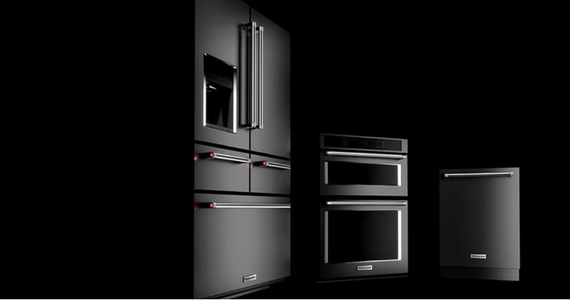In just over a month, the popular design conference, Dwell on Design, will be held in New York City. While we won't be able to attend, we were able to snag some face time with some of the companies and individuals who will be representing some of our favorite kitchen brands.
More specifically, we got the opportunity to speak with Jason Tippetts - the lead designer for KitchenAid - to talk about their new line of Black Stainless Steel appliances and the creative process that helps steer KitchenAid's new product creation. See below for the interview.
HP: How did you get into the field of design and what is the coolest thing you have ever designed?
I was always creative and a problem solver. I never took classes, but when I got into college, I started to explore architecture. Then, a friend who I'd grown up with introduced me to the field of industrial design. He inspired me and influenced me to try it and see if it was a right fit for me. I went through that program and it just clicked. It gave me a creative outlet, but it also had a functional focus at the end. That's really where it all started.
While I was in school, I had a few internships, was exposed to outdoor hunting equipment, lighting, consumer electronics - even toys. My first job was working for a company that made golf bags and [products]. But I wanted to find a job where I could be exposed to more things and be exposed to the manufacturing processes. And [I've been at] KitchenAid since 2008.
HP: What do you currently love about today's kitchen? And what do you dislike about it?
I love the "gathering" aspect of the kitchen. The kitchen brings loved ones together at any and all times of the day, and the room has so much presence in a house compared to other rooms. The kitchen and its appliances impact daily life.
What I dislike about the kitchen is the disconnect between the materials and systems that live in the space: wall construction, electrical wiring, plumbing systems, appliance manufacturers, etc. There are converging problems between these systems, and we need better synergies and product integrations to make the kitchen an even better space. Design is just as important to the kitchen as the objects and appliances within it."
HP: Putting aesthetics aside for a moment, what are the 2 biggest functionality issues that you are trying to tackle with design in KitchenAid products?
How do you create a balance of machine versus furniture? And how can this be done globally? That was the biggest challenge, and part of that was that we were tasked with taking this design global. It was about mainly Europe, and knowing we were going to be branching into different regions. [We needed] to partner European design with North American design sensibility, and we wanted Europeans to want American design. We needed a balance between the two.
The big point is that it's still a professional piece of equipment that needs to be integrated into a home. So what we have is a minimalist and modern design with an American aesthetic.
There's also this desire in the market to turn to simplicity and compartmentalization because it helps us de-clutter, and it's one of the reasons why design is finding its way further down into the mass markets. People are busier and busier and find products that de-clutter certain elements of their life through design. A return to simplicity.
HP: How do you see Kitchen Aid's design aesthetic evolving over the next 5 years?
KitchenAid appliances are uniquely designed and manufactured. Our major appliance proportions and lines are clean and elegant, but are still reminiscent of commercial-style, or restaurant-style, appliances. More specifically, they are capped off with polished inlay and color (the red medallion) to add key KitchenAid personality to each appliance, which is reminiscent of our iconic stand mixer design.
In the next 5 years, I envision a continuation of color, finish and material advances for appliances. I think kitchen appliances will become part of the overall furniture story in the kitchen space, instead of separate machinery, and their design will continuously be refined to fit the needs of consumers and designers.
HP: Two words I think of when I look at the design of KitchenAid appliances are Strong and Elegant. What are the design challenges and opportunities that arise when a product has to be two things that are seemingly on opposite ends of the spectrum?
You don't want to end up in the cliche "strong appliance" box. Part of that was for global appeal, and we felt like it was overkill - too much like a cartoon of itself. From that standpoint, we knew what would be over-the-top and what to avoid. But, how could we hint at some of those things through proportion and scale - i.e., "This feels like a commercial appliance, but it also feels elegant and thoughtful because someone paid attention to the details - like the towel bar handle or the microedge satin finish with just enough tactility."
To read more about KitchenAid's design and innovation process, check out the full interview here.
